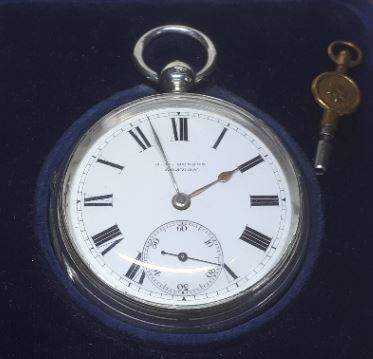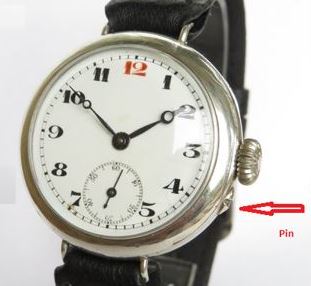In watchmaking, a movement, also known as a calibre, is the timekeeping mechanism of a watch. This is separate from the case, which encloses and protects the movement, and the dial, which displays the time. The term originated with mechanical timepieces that have clockwork movements consisting of many moving components.
Common types of watch movements
Key-wind, key-set movements
The earliest pocket watches, since their creation in the 16th century, up until the late 19th century, had key-wind and key-set movements. A watch key was required to manually wind the watch and to set the time. This was normally done by opening the case back and inserting the key into the winding-arbor, which was set over the watch’s winding-wheel to wind the mainspring. To set the time, the key would be placed onto the setting-arbor. This was connected with the minute-wheel and turned the hands. The setting-arbor could be located beneath the case back. However, some watches had the setting-arbor at the front of the watch. In this instance, opening the crystal is required to set the time.
Stem-wind, stem-set movements
The second type of movement that is commonly found in watches is the stem-wind and stem-set movement. The movement was invented in 1842 by Adrien Philippe. It was commercialised by Patek Philippe and Co. in the 1850s. The stem-wind stem-set movement eliminates the need for watch keys, which were necessary for earlier watch movements. Stem-wind, stem-set movements are the most common type of watch-movement found in both antique and modern pocket watches.
The transition to the use of stem-wind, stem-set watches occurred at around the same time as the end of the manufacture and use of the fusee watch. Fusee chain-driven timing was no longer required after the introduction of higher quality mainspring steel. It was made of spring steel, inside of what was commonly known as the “going barrel”, which allowed for a more even release of power to the escape mechanism. As a result of the new mainsprings and the going barrel, watches became much more accurate.
Stem-wind, lever-set movements
The third type of movement is the stem-wind, lever-set movement. The lever was a “switch”, which prevented the accidental changing of time. Pocket watches using a stem-wind, lever-set movement were set by opening the crystal dial cover and pulling out a special setting lever. However, some hunter-cases make the lever accessible without removing the crystal covering. The lever is usually found at either the 10:00 or 02:00 positions in open-face pocket watches and at 05:00 on hunter-case watches. Once pulled, the lever allowed the crown to be turned to set the time. The lever was then pushed back in and the crystal dial cover closed. This method of setting was preferred by major railroads as it made accidentally changing the time nearly impossible. Railroad watches manufactured after 1908 were required to use this type of movement.
Stem-wind, pin-set movements
A fourth type of movement is the stem-wind, pin-set movement. This is similar to the lever set movements, in that the pin works as a “switch” to prevent the accidental changing of time. Pocket watches with this type of movement have a small pin or knob next to the watch that needs to be pressed in order to set the time. The crown is then turned to move the hands. When finished, the pin is released and the time is officially set. This type of movement is also sometimes referred to as the nail set. This is because the set button required a small object, such as a fingernail, to press.
Specific movements and components
Cylinder escapement
The cylinder escapement was invented in England by Thomas Tompion (1639–1713) in 1695. It was perfected in 1726 by George Graham, an apprentice to Tompion. It was also known as the horizontal escapement, in contrast to the vertical verge escapement that preceded it.
Fusee movement
The fusee movement includes a special gear-like component called the fusee that helps minimise the effect of reduced power as the mainspring unwinds.
Gear or wheel train
A gear train is a mechanical system formed by fitting gears on a frame so that the teeth of the gears engage. The gear train on an antique watch is also known as the wheel train and transfers power from the mainspring to the escapement and the balance wheel.
The balance
The balance wheel, combined with the hairspring, is the critical timekeeping component of the movement. It forms an oscillator that controls the release of power from the mainspring barrel and therefore the timekeeping of the watch.
The lever escapement
The lever escapement is a key component of an antique watch moment. It controls the transmission of power from the gear train into a series of impulses that are passed to the balance wheel. The ticking sound you hear when holding a watch to your ear is from the escapement.
The mainspring
A mainspring is a spiral metal spring used as a power source in mechanical watches and clockwork mechanisms. Winding the timepiece, by turning the crown or a key, stores energy in the mainspring by twisting the spiral tighter. The force of the mainspring then turns the watch’s gear wheels as it unwinds.
Verge escapement
The verge escapement is the earliest known type of mechanical escapement. It is also known as the crown wheel because of its appearance. The escapement is the mechanism in a mechanical timepiece that controls the transmission of power from the gear train to the balance wheel.
Watch movement plates
Movement plates provide the housing for the inner components of the watch and contain the jewels, pivots, and screw holes. The top plate, which usually contains the manufacturer’s signing name and serial number, can be easily seen by opening the case back and dust cover of an antique watch.

